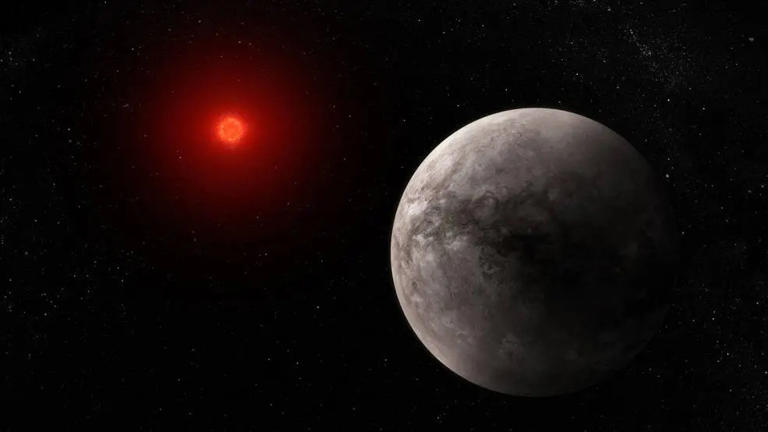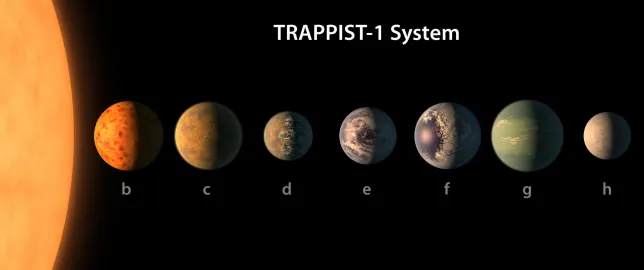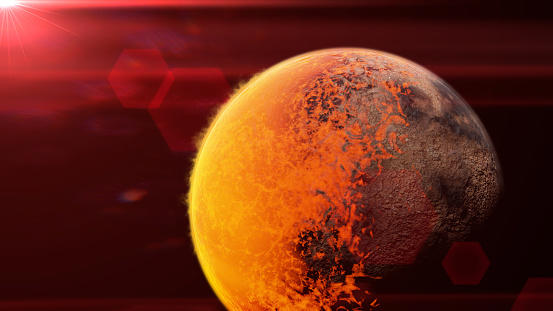WEBB TELESCOPE DETECTS LIGHT FROM AN EARTH-LIKE PLANET



















Webb telescope detects light from an Earth-like planet
Light has been detected from a planet similar to Earth – but it has no atmosphere.
Nasa’s infrared Spitzer Space Telescope discovered several rocky exoplanets orbiting a star known as TRAPPIST-1.
But now, thanks to the James Webb Space Telescope, also known as the Webb, one of the rocky exoplanets orbiting the star has had its temperature measured.
The planet, known as TRAPPIST-1b, gives off no visible light but instead has an infrared glow.
Dr Pierre-Olivier Lagage, a co-author on the study, said: ‘There was one target that I dreamed of having.
‘And it was this one. This is the first time we can detect the emission from a rocky, temperate planet. It’s a really important step in the story of discovering exoplanets.’
The researchers found that TRAPPIST-1b is also blistering hot, clocking in at roughly around 230C – which is around the temperature of an oven.
However, even though it probably lacks an atmosphere, the planet is the first to have any form of light by an exoplanet as small and as cool as the rocky planets in our solar system, Nasa said.
‘No previous telescopes have had the sensitivity to measure such dim mid-infrared light.’
The find is an important step in determining whether planets orbiting small active stars like TRAPPIST-1 can house atmospheres needed to support life.
The seven planets initially caused great excitement as all the distant worlds were around the size of Earth but had an M-dwarf star – the coolest and smallest type of star – as their host.
However, TRAPPIST-1 b, is the innermost planet and receives about four times the amount of energy that Earth gets from the Sun.
Previous observations of the planet were not sensitive enough to determine if it had an atmosphere or if it was just a rocky planet, but simulations of the tide-locked planet – meaning one side always faces its host – would suggest that the planet would have a lower temperature and as the air would redistribute the heat around both sides.
However, the Webb detected a significantly hotter temperature, suggesting it has no atmosphere and, unfortunately, adds to the list of planets that cannot house humans.
The study is published in the journal Nature.
Story by Hiyah Zaidi: Metro
Articles - Latest
- Earthquakes can trigger quartz into forming giant gold nuggets, study finds
- Linda Nolan, singer and television personality, dies aged 65
- Sly Stone, pioneering funk and soul musician, dies aged 82
- Dangers of an overloaded car include:
- Natural Disaster today
- Japan earthquake: Kushiro shakes for 'too long' as 6.1 mag tremor hits
- 'Cult' members jailed over coroner kidnap plot
- Flood risk threatens Swiss valley after glacier destroys village
- Thailand Grapples with Floods and Economic Shifts: Government Response, Community Resilience, and Market Predictions
- Powerful hailstorm floods buildings and streets in Gniezno
- The Significance of the 49-Day Journey After Death
- Killing prisoners for transplants: Forced organ harvesting in China
- Southern Japan hit by 6.6-magnitude quake near Nankai Trough, tsunami warnings lifted
- Peru’s coastline battered by tsunami-like waves one day after country declares environmental emergency
- California fires live updates: ‘Dangerous’ winds return as residents are warned over threat of new wildfires
- Osibisa founding member and singer Teddy Osei dead at 88
- Oliviero Toscani, photographer behind shock Benetton ads, dead at 82
- California LA Mayor Karen Bass awkwardly ignores questions from reporter about California fires
- UK set for more freezing weather as homes and businesses deal with flooding
- Jean-Marie Le Pen dead at 96: His political career through the years
- Jimmy Carter, former US president, dies aged 100
- ‘Jazz’s most significant composer’ Benny Golson dies at 95
- Billionaire founder of fashion chain Mango dies in accident
Articles - Most Read
- Main
- Contact Us
- The science behind Ouija boards
- Cosmic Consciousness - What is Cosmic Consciousness-2
- Cosmic Consciousness-Introduction
- Cosmic Consciousness - Introduction-2
- MASSIVE 6.1 MAGNITUDE EARTHQUAKE HITS NEW ZEALAND AS NATION STILL REELING FROM CYCLONE
- ARCHAEOLOGISTS UNRAVEL THE TRUTH OF APHRODITE, GODDESS OF LOVE, ON VALENTINE'S DAY
- Cosmic Consciousness First Words - 1V - 2
- The Human Condition-Thomas Keating
- Cosmic Consciousness First Words - V -
- Cosmic Consciousness V - 2
- Cosmic consciousness - First Words - IV
- Shakyamuni Buddha or India the 1st “Black Revolutionary Hero.”
- Cosmic Consciousness - What is Cosmic Consciousness?
- The Human Condition-2-Thomas Keating
- Evolution and Devolution-Chapter 2
- The Human Condition - Thomas keating-3
- Cosmic Consciousness-On the Plane of Self Consciousness
- Drinking From The Mountain Stream - Milarepa
- The Human Condition - 4
- Cosmic Consciousness - 3 - On the Plane of Self Consciousness
- The Human Condition - 6
- Evolution and Devolution-Chapter 1
- Contemplation and the Divine Therapy - 2
- On the Plane of Self Consciousness - 2
- The Buddhist System of Liberation - 2
- Milarepa's World-2
- The Human Condition - 5
- Milarepa's World
- On the Plane of Self Consciousness IV
- The Buddhist System of Liberation
- On the Plane of Self Consciousness IV - 2
- JERRY RAWLINGS, GHANAIAN STRONG MAN WHO CAME TO POWER IN A COUP BUT INTRODUCED DEMOCRACY – OBITUARY






